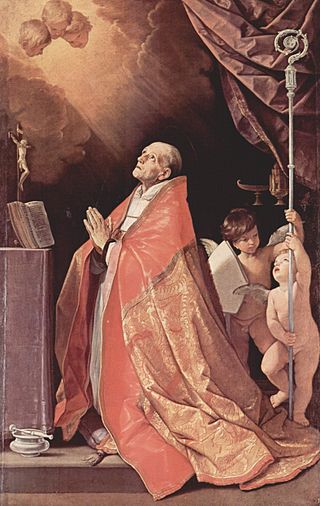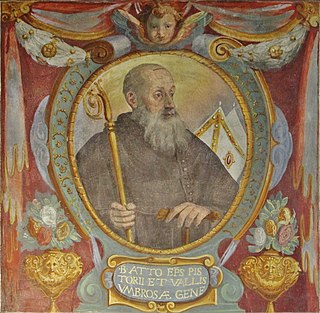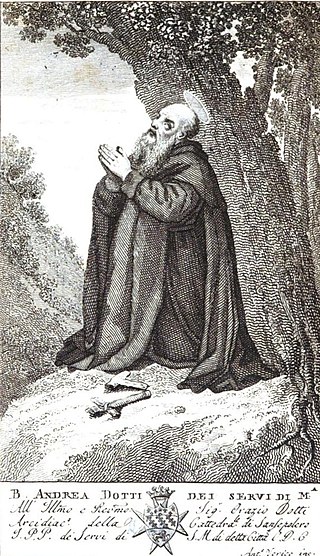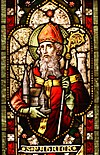
Amandus, commonly called Saint Amand, was a bishop of Tongeren-Maastricht and one of the catholic missionaries of Flanders. He is venerated as a saint, particularly in France and Belgium.

Fiesole is a town and comune of the Metropolitan City of Florence in the Italian region of Tuscany, on a scenic height above Florence, 5 km northeast of that city. It has structures dating to Etruscan and Roman times.

Agnes of Montepulciano was a Dominican prioress in medieval Tuscany, who was known as a miracle worker during her lifetime. She is honored as a saint by the Catholic Church.

Saint Genesius is a French saint. He was the twenty-first Bishop of Clermont and his feast day is celebrated on June 3.
Ælfwold II was a Bishop of Sherborne in Dorset. He is venerated as a saint in the Catholic Church.

Donatus of Fiesole was an Irish teacher and poet, and Bishop of Fiesole.

Andrea Corsini was an Italian Catholic prelate and professed member from the Carmelites who served as the Bishop of Fiesole from 1349 until his death.

Saint William of Perth, also known as Saint William of Rochester was a Scottish saint who was martyred in England. He is the patron saint of adopted children. Following his death, he gained local acclaim and was canonised by Pope Alexander IV in 1256.

Atto of Pistoia, or Saint Atto, was a Catholic bishop and a professed member from the Vallumbrosan Order as well as the Bishop of Pistoia and a noted historiographer.

Saint Erhard of Regensburg was bishop of Regensburg in the 7th century. He is identified with an Abbot Erhard of Ebersheimmunster mentioned in a Merovingian diploma of 684. Ancient documents call him also Erard and Herhard.

William of Maleval, also known as William the Hermit or William the Great, was a French Christian and the founder of the Catholic congregation of Williamites, an early branch of the Hermits of St. Augustine. He was beatified in 1202.

Saint Simeon Stylites the Younger, also known as Simeon of the Admirable Mountain, is a saint in the Catholic Church and Eastern Orthodox Church.
Colman mac Cathbaid is a sixth-century Irish saint who was an abbot and bishop of Kilroot, a minor see which was afterwards incorporated in the Diocese of Connor. He may have given his name to Kilmackevat.
Mo Chua or Crónán mac Bécáin, also called Claunus, Cuan, Mochua, Moncan and Moncain was a legendary Irish saint who founded the monastery in Balla.

Andrea Dotti was an Italian Servite preacher. His feast day is September 3.
Aibertof Crespin, was a Benedictine monastic and hermit revered for his intense life of prayer, asceticism and devotion to Mary. His biography was written by a contemporary, Robert, Archdeacon of Oostrevand.

Richard the Pilgrim or Richard of Wessex was the father of the West Saxon saints Willibald, Winnibald, and Walpurga. He led his family on a pilgrimage to the Holy Land but died en route in Lucca, where he was buried in the church of Saint Fridianus.
St. Bridget of Fiesole is an Irish Saint whose festival is celebrated in Italy on 1 February.
Hilarinus was a martyr who died with Donatus of Arezzo during the persecutions of the Roman Emperor Julian. His feast day is 16 July.

Saint Silaus of Lucca was an Irish bishop who died in Lucca, Tuscany, while returning from a pilgrimage. His feast day is 17 May.















